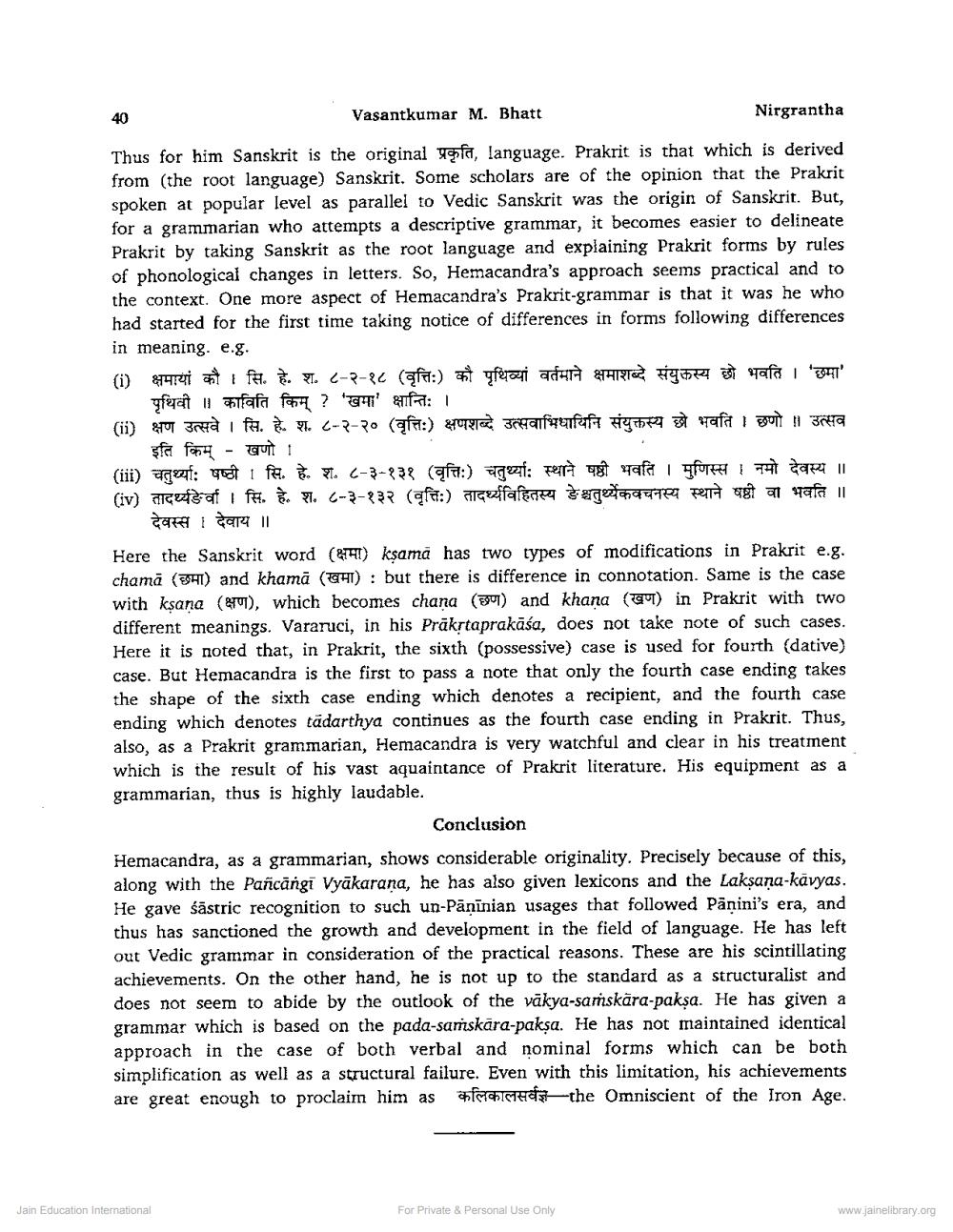Book Title: Kalikal Sarvagna Acharya Hemchandra A Re Appraisal Author(s): Vasant M Bhatt Publisher: Z_Nirgrantha_1_022701.pdf and Nirgrantha_2_022702.pdf and Nirgrantha_3_022703.pdf View full book textPage 6
________________ Vasantkumar M. Bhatt Nirgrantha Thus for him Sanskrit is the original wofa, language. Prakrit is that which is derived from (the root language) Sanskrit. Some scholars are of the opinion that the Prakrit spoken at popular level as parallel to Vedic Sanskrit was the origin of Sanskrit. But, for a grammarian who attempts a descriptive grammar, it becomes easier to delineate Prakrit by taking Sanskrit as the root language and explaining Prakrit forms by rules of phonological changes in letters. So, Hemacandra's approach seems practical and to the context. One more aspect of Hemacandra's Prakrit-grammar is that it was he who had started for the first time taking notice of differences in forms following differences in meaning. e.g. (i) 4841 fH. . 1. (-2-86 (çfa:) yfergi ada yafe '3040' at l afa fetim? 'GY : (ii) 0 Bradfa. . 2--70 (afr:) og 307affet hy they rafat I got !1 367 sfa form - at (iii) agat: o fe. 1. 6-3-838 (afer:) aqzf: F o gt yafe i fore I tapi il (iv) arcuts affhệ . 6-3-837 (afa:) aigzfafenea faqe e PT ogt at afat 11 aki dar || Here the Sanskrit word (7) kşama has two types of modifications in Prakrit e.g. chama (SH) and khama (CH) : but there is difference in connotation. Same is the case with kşana (01), which becomes chana (394) and khana (C) in Prakrit with two different meanings. Vararuci, in his Prākstaprakāśa, does not take note of such cases. Here it is noted that, in Prakrit, the sixth (possessive) case is used for fourth (dative) case. But Hemacandra is the first to pass a note that only the fourth case ending takes the shape of the sixth case ending which denotes a recipient, and the fourth case ending which denotes tadarthya continues as the fourth case ending in Prakrit. Thus, also, as a Prakrit grammarian, Hemacandra is very watchful and clear in his treatment which is the result of his vast aquaintance of Prakrit literature. His equipment as a grammarian, thus is highly laudable. Conclusion Hemacandra, as a grammarian, shows considerable originality. Precisely because of this, along with the Pancāngi Vyakarana, he has also given lexicons and the Laksana-kavyas. He gave śāstric recognition to such un-Pānīnian usages that followed Panini's era, and thus has sanctioned the growth and development in the field of language. He has left out Vedic grammar in consideration of the practical reasons. These are his scintillating achievements. On the other hand, he is not up to the standard as a structuralist and does not seem to abide by the outlook of the vākya-saṁskāra-paksa. He has given a grammar which is based on the pada-samskara-paksa. He has not maintained identical approach in the case of both verbal and nominal forms which can be both simplification as well as a structural failure. Even with this limitation, his achievements are great enough to proclaim him as fichichesthe Omniscient of the Iron Age. Jain Education International For Private & Personal Use Only www.jainelibrary.orgPage Navigation
1 ... 4 5 6 7 8
